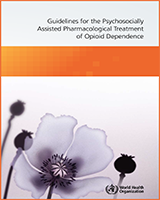All rights reserved. Publications of the World Health Organization can be obtained from WHO Press, World Health Organization, 20 Avenue Appia, 1211 Geneva 27, Switzerland (tel.: +41 22 791 3264; fax: +41 22 791 4857; e-mail: tni.ohw@sredrokoob). Requests for permission to reproduce or translate WHO publications – whether for sale or for noncommercial distribution – should be addressed to WHO Press, at the above address (fax: +41 22 791 4806; e-mail: tni.ohw@snoissimrep).
NCBI Bookshelf. A service of the National Library of Medicine, National Institutes of Health.
Guidelines for the Psychosocially Assisted Pharmacological Treatment of Opioid Dependence. Geneva: World Health Organization; 2009.

Guidelines for the Psychosocially Assisted Pharmacological Treatment of Opioid Dependence.
Show detailsA6.1. Heroin maintenance
The limited evidence is inadequate to support any recommendations on heroin maintenance.
A Cochrane review of heroin prescription identified five RCTs comparing heroin with methadone [287]. It was not possible to draw definitive conclusions about the overall effectiveness of heroin prescription because the experimental studies available were not compatible. Heroin use in clinical practice is still a matter of research in most countries. Results favouring heroin treatment over methadone come from studies conducted in patients who have failed previous methadone treatments.
A6.2. Slow or sustained-release oral morphine
The limited evidence is inadequate to support any recommendations on slow or sustained-release oral morphine.
Recent formulations of morphine can be used in once-daily doses for the treatment of chronic pain [288, 289, 290] and there have been a number of studies of these formulations in opioid dependence [210, 291, 292, 293]. The results of these trials are promising, demonstrating a long duration of action of morphine and comparable levels of self-reported heroin use to methadone treatment. The use of morphine in the treatment of addiction is complicated by difficulties in assessing heroin use and supervising doses.
A6.3. Levo-alpha-acetylmethadol
Although still registered in the United States, levo-alpha-acetylmethadol (LAAM) has been withdrawn from the market by the manufacturer, due to the risk of life-threatening cardiac arrhythmias.
Levo-alpha-acetylmethadol (LAAM) is a long-acting opioid agonist approved for use as a maintenance treatment for opioid dependence. For persons in whom methadone and buprenorphine are not effective, LAAM offers an alternative effective medication. In a Cochrane review and recent RCT, LAAM was found to be better at suppressing heroin use than methadone [294, 295] but its use is, at present, limited by its effect of QT prolongation [296]. The active metabolite – nor-acetylmethadol – does not have the same effect on QT prolongation [131, 297], and may be a promising treatment alternative.
A6.4. Buprenorphine-naloxone combination
The limited evidence is inadequate to support any recommendations on a buprenorphine–naloxone combination. However, the combination is likely to have similar efficacy to buprenorphine alone.
As with methadone, intravenous abuse of buprenorphine has been reported in many countries [119, 128, 298, 299, 300, 301, 302, 303]. Buprenorphine–naloxone comprises the partial agonist buprenorphine in combination with the opioid antagonist naloxone in a 4:1 ratio. It is hoped that by the addition of naloxone, the resulting product will be less subject to abuse by injection than buprenorphine alone. When the combination is taken sublingually, absorption of naloxone is minimal and the opioid agonist effects of buprenorphine should predominate. However, when buprenorphine–naloxone tablets are injected, naloxone will induce withdrawal in people dependent on opioids other than buprenorphine [269, 271, 304].
Efficacy of buprenorphine/naloxone in maintenance therapy for opioid dependence is described in three RCTs in comparing the combination with placebo [305] and clonidine [226], and comparing stepped combination-based treatment with methadone treatment alone [306]. Three trials investigating the efficacy of the combination with different counselling or medication-dispensing regimens have been published [307, 308, 309].
A6.5. Slow-release naltrexone implants and injections
The limited evidence is inadequate to support any recommendations on slow-release naltrexone implants and injections.
Injectable, slow-release naltrexone formulations provide clinically significant opioid blockade for 3-6 weeks (depending on the dose) in early clinical research [310, 311, 312, 313, 314].
A number of naltrexone implants have been developed that can be inserted subcutaneously using local anaesthesia, either post withdrawal or as part of an antagonist withdrawal treatment. Subsequent implants are inserted at 1–3 months intervals. There are no RCTs to assess the effectiveness of naltrexone implants, although there are some promising reports [315, 316, 317, 318]. Local implant site allergies and infections have been described with implantable formulations.
- Alternatives for the treatment of opioid dependence not included in the current ...Alternatives for the treatment of opioid dependence not included in the current guidelines - Guidelines for the Psychosocially Assisted Pharmacological Treatment of Opioid Dependence
Your browsing activity is empty.
Activity recording is turned off.
See more...